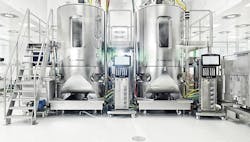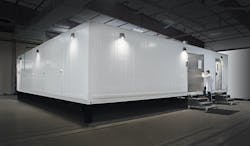Disposable Equipment Makes Lasting Gains
Figure 1. Chinese developers are relying on single-use bioreactor to produce possible vaccine for Covid-19. Source: Sartorius Stedim Biotech.
Single-use equipment can provide processors with a number of benefits — including faster plant set-up and turnaround between batches, improved product flexibility, reduced capital expenditure and quicker time-to-market for products. That’s why such equipment is playing a significant role in the development of diagnostics and vaccines for Covid-19, note various vendors. However, the growing popularity of single-use devices long predates the pandemic and will continue increasing afterward, they stress.“The flexibility of single-use facilities to be used for multiple different processes, depending on demand, is relevant in both rapid development and streamlined manufacturing,” says Melisa Carpio, global technology consultant, cell culture technologies, Sartorius Stedim Biotech, Bohemia, N.Y.
The importance of rapid development was brought into sharp focus on March 25 when Sartorius announced that CanSino Biologics, Tianjin, China, in conjunction with the Institute of Bioengineering at the Academy of Military Medical Sciences, Beijing, was using its Biostat STR single-use bioreactor system to bring what at that stage was the first vaccine candidate against Covid-19 to clinical trials (Figure 1).
Opting for the single-use bioreactor cut the amount of time needed to prepare the vaccine to several weeks from several months. The project also built upon experience gained during a similar 2017 collaboration between the two Chinese organizations and Sartorius. In that case, a Biostat STR50 bioreactor system featured in the development of a recombinant vaccine against the Ebola virus — the first registered Ebola vaccine in the world.
Today, Sartorius offers standard bag designs for the most-common processing configurations. It also provides configured-to-order and engineered-to-order options for custom designs that can range from simple, such as dual redundancy for sensors like those for pH and dissolved oxygen, to more complex, such as modified dip-tube lengths for microcarrier cultures.
“Over the years, we have had to adapt to the trends of the bioprocessing industry, like adding ports and patches for process analytical technologies (PAT), as in our BioPAT Viamass, Trace and Spectro. In addition, bag designs have been modified to allow for connectivity to cell retention devices like alternating tangential flow filtration for use in intensified processing,” Carpio explains.
The company’s latest version of Biostat STR, generation three, has a fully configurable control tower that can work with any bag holder size from 50–2,000 L. The bags feature a traditional top-drive motor and an impeller design comparable to stainless steel ones, and suit multiple cell types in a range of applications including high density, microcarrier and perfusion cultures.
“It comes with standard configurations that can be upgraded easily to adapt to process or application changes. In addition, as other features like additional PAT tools become available, the new STR has been designed to accommodate them mostly via software upgrades, with no changes needed to the hardware,” she adds.
The main challenge single-use bioreactors face today is the large number of batches needed to meet annual demands of traditional fed-batch processes.
“However, with higher titre processes and process intensification, volume requirements for commercial cell culture bioreactors are trending towards lower volumes. According to Bioplan’s “2019 Biomanufacturing Report” [BioPlan Associates, Rockville, Md.], the greatest demand was for 1,000-L single-use bioreactors, followed by 500-L, and then 2,000-L,” Carpio notes.
The company also has launched its first 3D-printed single-use part — a port integrated into the Flexsafe STR bags used with the new BioPAT Spectro platform.
“It’s a flow-cell-based design that allows for non-invasive, at-line samples to be taken and it decouples the measurement from disturbances such as gassing and stirring caused by process conditions. It also benefits from a shielded design so that any interference from ambient light is eliminated,” comments Carpio.
Attention To Automation
Thermo Fisher Scientific, Waltham, Mass., which also is involved with several biopharma companies working to develop a vaccine for Covid-19, sees automation of single-use equipment as an important focus. Its new HyPerforma TruBio Discovery software system, based on Emerson’s DeltaV platform, meets bioprocessors’ demands for reduced risks associated with technology transfer and manufacturing, says vice president and general manager Steve Lam.
“We are able to offer small- to mid-size research and process development (PD) labs a cost-effective, yet robust control platform that can be easily employed during tech transfer and scale-up. Our customers are embracing this solution because our open architecture approach allows them to not only use pre-existing hardware but to also adopt new equipment and peripherals on the same platform, while taking advantages of reduced operator training as they move from R&D to PD to manufacturing,” he explains.
Meanwhile, development continues on the company’s new HyPerforma DynaDrive single-use bioreactor (SUB). Work started last September and the first of the new bioreactors, a 50-L model (Figure 2), is due for release later this year. Three other sizes, up to 5,000 L, should reach the market in early 2021.
Figure 2. Line of units, ranging from 50-L to 5,000-L capacity, is aimed at current good manufacturing practice facilities. Source: Thermo Fisher Scientific.
“The new bioreactor technology is designed to meet changing demands as the market is maturing and increasingly looking to adopt single-use technologies in current good manufacturing practice (cGMP) facilities,” notes Lam.
The DynaDrive SUB currently is going through extensive internal and customer testing. “Early data from testing has shown excellent mixing times and volumetric mass transfer coefficient (kLa) data, and cell densities well over 200 million cells/mL can be achieved,” comments Lam. That coefficient often is used to compare the efficiency of bioreactors and as an important scale-up factor.
The company is making major investments in bioprocess container (BPC) chambers and their final assemblies at its three main manufacturing sites in Cramlington, U.K.; Millersburg, Pa.; and Logan, Utah, as well as expanding manufacturing capabilities in the Asia Pacific region with new BPC centers in Suzhou, China, and Singapore. “As single-use technology adoption continues, it is important to us to bring the manufacturing process closer to our customers,” Lam adds.
More Developments
For its part, Cytiva, Marlborough, Mass., is collaborating with both Sona Nanotech, Halifax, N.S., and Avacta, Wetherby, U.K., in the development of Covid-19 test technology.
The company has observed an increase in the adoption of single-use equipment across clinical and commercial production over recent years as several biologics developed using single-use systems have moved through clinical-scale manufacturing and on to regulatory approval and commercial production.
The 2019 BioPlan report cited a 15–20% increase in respondents indicating their biomanufacturing systems were single-use/disposable, compared to a similar survey in 2017, points out Chor Sing Tan, Cytiva senior consumables application leader.
“Most of the new single-use technology equipment and enabling technology focuses on improvement of features and reliability to meet the industry drives toward a connected, continuous and closed manufacturing. Thus, either in standard or through custom engineering solutions, suppliers have introduced modular hardware and plug-and-play automation approaches to the second generation of single-use bioreactor and mixing systems,” he says.
More-robust sensors are emerging, too, overcoming past challenges with short shelf life after gamma irradiation, measurement drift, and issues with fiber optic and wireless connections to transmitters.
“Today, they are mostly used to monitor common parameters including pH, dissolved oxygen, flow rate, temperature and pressure. However, outstanding monitoring challenges remain, including total cell density, viable cell density, foam detection, glucose and lactate concentrations,” he explains.
3D printing is coming of age, too, he notes. It already manufactures some downstream equipment including chromatography columns and surface plasmon resonance devices for measuring biomolecular interactions, and also helps the company’s product development team create rapid prototypes of single-use components for engineering testing.
The company continues development of its FlexFactory configurable single-use platform and KUBio off-the-shelf modular, prefabricated manufacturing facilities (Figure 3). It now offers two KUBio modules for Biosafety Level 2 (BSL-2)-classified operations. “We have looked into different viral vector processes and been able to create a large-scale solution, KUBio BSL-2, and an indoor module solution, KUBio box, for viral vectors,” comments Johan Rosenquist, global operations director KUBio, Uppsala, Sweden.
Figure 3. Off-the-shelf, prefabricated manufacturing facilities now are available for Biosafety Level 2 operations. Source: Cytiva.
“Both are designed according to BSL-2 class with unidirectional flows and the corresponding HVAC/air pressure technologies. Collaborations with industry specialists such as Pharmadule and Germfree are important in order to develop solutions and help biopharma manufacturers access the market faster,” he adds.
In fact, Cytiva and modular plant specialist Pharmadule Morimatsu, Nacka, Sweden, are currently finishing the installation and commissioning of 54 modules for a KUBio facility being built at the Lonza Biologics plant in Guangzhou, China.
Meanwhile, operation of a FlexFactory bioprocessing platform already has begun at Clover Pharmaceuticals, Chengdu, China. In addition, work continues with the company’s FlexFactory platform at Bayer’s $150-million cell-culture technology center in Berkeley, Calif., that will initially house two 2,000-L single-use bioreactors with room to double this if needed in the future.
Larger Interest
“In the last three years, we have seen significant uptake of our large-scale single-use solutions, which enable improved economies of scale and lower cost of goods versus the standard 2,000-L bioreactor-based processes,” says Brady Cole, vice president, equipment solutions, for ABEC, Bethlehem, Pa.
Last September, for example, the company added a 6,000-L custom single run (CSR) bioreactor to a product line that already included bioreactors up to 4,000 L, fermenters up to 1,000 L, and liquid mixing systems up to 5,000 L. Delivery of significantly more capacity per unit area of floor space is a key metric in high-value, multi-product biopharmaceutical facilities, Cole notes.
By way of example, he cites WuXi Biologics, Wuxi, China. Two years ago, it selected ABEC’s 4,000-L CSR disposable bioreactors (Figure 4) for a new commercial manufacturing facility in Wuxi. The Chinese company has pioneered the use of multiple disposable bioreactors for commercial manufacturing and the new CSRs enabled it to raise global manufacturing capacity to more than 100,000 L.
Figure 4. Chinese manufacturer has opted for 4,000-L disposable units at new commercial manufacturing facility. Source: ABEC.
At a time when improving titers (g/L of product) can drive bioreactor size reductions, Cole says many applications remain at titer levels where large-scale single-use bioreactors are optimum. “Also, higher titers generally drive larger equipment for the downstream process,” he adds.
ABEC long has treated customization as key, first with stainless steel equipment decades ago and now with single-use technologies. It provides this via its flexible manufacturing platform (FMP). Launched last September, the FMP brings together the company’s scalable single-use products and its legacy stainless-steel technologies into one platform. “Importantly, we are the only supplier with a fully agnostic view when it comes to single-use implementation, since we can provide single-use, stainless steel, or hybrid solutions. Which we supply depends entirely on a customer’s specific needs,” Cole stresses.
In terms of single-use sensor technology, ABEC regularly integrates pH and dissolved oxygen sensors in its bioreactors and fermenters. It also is tracking developments in optical density probes and efforts to prolong the limited shelf-life of some sensors.
The company also has built on its long experience with mixing/gas-transfer technology to adapt its stainless-steel low-shear mixers to single-use format using different materials of construction. “Different cultures have different shear sensitivities, so, again, we customize mixing to individual customer processes,” says Cole.
“At the end of the day, the single-use versus stainless-steel decision is case-by-case depending on multiple technical and business considerations such as bioreactor titer, production quantities needed, number of different products to be produced, time-to-market goals, regulatory considerations, geographic location, and so on,” he concludes.
Seán Ottewell is Chemical Processing's editor at large. You can email him at [email protected].





